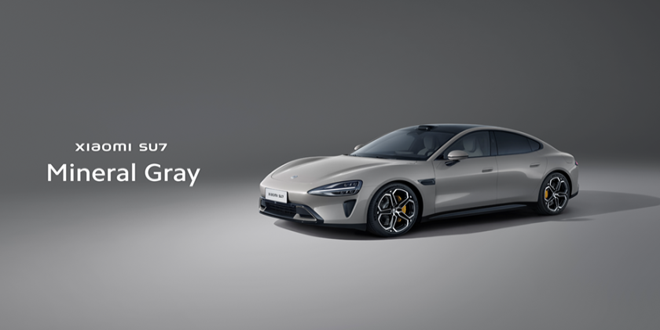

Xiaomi recently hosted its Xiaomi EV Technology Launch, officially introducing five core technologies that power Xiaomi EV – E-Motor, Battery, Xiaomi Die-Casting, Xiaomi Pilot Autonomous Driving, and Smart Cabin. The unveiling of these foundational core technologies signifies Xiaomi’s ambition to redefine the automotive industry’s technological landscape.
The debut product from Xiaomi EV, the eagerly awaited Xiaomi SU7, has been “pre-launched,” providing a global debut of its design, performance, range, safety features, and more. Positioned as a “full-size high-performance eco-technology sedan,” the Xiaomi SU7 aspires to push the boundaries of performance, ecosystem integration, and the mobile smart space.
Founder, Chairman, and CEO of Xiaomi Group, Lei Jun, shared a poignant sentiment from Chinese poetry during the launch: “With firm strides, we are crossing its summit.” He highlighted that Xiaomi’s foray into the automotive industry marks a significant departure from the smartphone sector and a crucial step toward completing the loop of the Human x Car x Home smart ecosystem. Lei Jun emphasized that the century-old automotive industry presents limited opportunities today, and Xiaomi’s decision to invest significantly in fundamental core technologies reflects its commitment to building an exceptional vehicle. Looking ahead, Lei Jun stated that, through 15 to 20 years of dedicated effort, Xiaomi aims to secure a place among the top five global automakers.
The integration of smart electric vehicles with consumer electronics and intelligent ecosystems is reshaping the automotive industry. Lei Jun emphasized that Xiaomi EV, by combining industrial manufacturing, smart software, and AI, plans to redefine the automotive industry’s technology stack, representing a significant technological leap.
Xiaomi EV adheres to a bottom-up approach, commencing with the development of foundational core technologies and thorough independent research in key technology sectors. With a pledge of “tenfold investment, conscientiously building a great car,” Xiaomi EV has invested over 10 billion CNY in the initial research and development phase. The R&D team, comprising over 3,400 engineers and over a thousand technical experts globally, has achieved breakthroughs in the development of Xiaomi EV’s five core technologies. These innovations in E-Motor, Battery, Xiaomi Die-Casting, Xiaomi Pilot Autonomous Driving, and Smart Cabin highlight Xiaomi’s comprehensive technological expertise accumulated over its 13-year history.

E-motor
During the conference, Xiaomi presented its independently developed and manufactured E-motors, featuring the HyperEngine V6/V6s, and the groundbreaking HyperEngine V8s. These three E-motors incorporate cutting-edge technologies such as Bidirectional Full Oil Cooling Technology, S-shaped oil circuit design, and staggered silicon steel laminations design. This technological prowess allows them to outperform traditional large V8 and V6 powertrains from the era of internal combustion engines, elevating industry performance to unprecedented levels.
The HyperEngine V8s, setting a global record for E-motors, boasts remarkable specifications, including a maximum speed of 27,200 rpm, 425kW output, and a peak torque of 635N·m. Achieving the industry-exceeding standard of 27,200 rpm is made possible by the use of the industry’s first ultra-high-strength silicon steel plate with a tensile strength of 960MPa, surpassing mainstream industry offerings by more than twice the strength.
For its cooling design, the HyperEngine V8s incorporates Bidirectional Full Oil Cooling Technology and an S-shaped oil circuit design. The stator employs a dual-cycle oil circuit, increasing the heat dissipation area by 100% and achieving a cooling effect of up to 20°C. Simultaneously, the rotor section features a patented S-shaped oil circuit, expanding the heat dissipation area by 50% and achieving a cooling effect of up to 30°C. Additionally, the stator silicon steel laminations utilize a “step-like” staggered design, further enhancing the effective heat dissipation area by an additional 7%.
Set to be mass-produced and implemented in Xiaomi EVs in 2025, the HyperEngine V8s is currently in development.
Xiaomi’s self-developed HyperEngine V6/V6s E-motors boast an industry-leading rotational speed of 21,000 rpm, surpassing any mass-produced electric motor globally. The HyperEngine V6 super motor features a maximum power of 299PS and a maximum torque of 400N·m, while the HyperEngine V6s super motor achieves a maximum power of 374PS and a maximum torque of 500N·m.
Battery
Xiaomi has pioneered CTB Integrated Battery Technology, leveraging innovative Inverted Cell Technology, a multifunctional elastic interlayer, and a minimalist wiring system. This groundbreaking technology achieves a battery integration efficiency of 77.8%, the highest globally for CTB batteries. It brings about a remarkable 24.4% overall performance improvement and reduces height by 17mm. The CTB Integrated Battery has a maximum capacity of up to 150 kWh, offering a theoretical CLTC recharge range exceeding 1200 km.
For long-range travel stability, Xiaomi prioritizes industry-leading safety design standards. The downward-facing pressure relief valve rapidly releases energy in extreme situations, ensuring optimal passenger cabin safety. The comprehensive 14-layer physical protection system includes three layers of top support, three layers of side protection, and eight layers of bottom protection.
Addressing heat dissipation, Xiaomi implements a dual-side water cooling solution with heat dissipation plates on both long sides of the battery cells, resulting in an expansive cooling area of 7.8m²—four times the industry average. The battery cells’ sides are equipped with 165 pieces of aerogel insulation material, capable of withstanding temperatures up to 1000°C.
Xiaomi EV features a self-developed Battery Management System (BMS) with ASIL-D, the highest functional safety level. This BMS incorporates three independent thermal runaway monitors and alarms, along with a 24/7 early warning system. Each Xiaomi battery undergoes rigorous safety testing, including 1050+ verifications and 96 times the international standard duration for durability testing, ensuring industry-leading reliability.

Xiaomi Die-Casting
Xiaomi has revealed its in-house developed Xiaomi Die-Casting T9100 cluster along with its proprietary die-casting alloy material, Xiaomi Titans Metal, marking it as the sole domestic automaker concurrently conducting independent research on both large die-casting and materials.
Spanning an area of 840m² and boasting a total weight of 1050t, the Xiaomi Die-Casting T9100 exerts an impressive locking force of 9100t. Xiaomi has introduced a groundbreaking foundation model quality judgment system capable of inspecting individual pieces within a mere 2 seconds, achieving an efficiency ten times higher than manual inspection. This cluster has played a pivotal role in the development of Xiaomi EV, facilitating the integration of 72 components into the rear underbody as a single unit. This integration has led to a reduction of welded joints by 840, resulting in a 17% decrease in overall car weight and a substantial 45% reduction in production hours.
In terms of material research and development, Xiaomi has introduced Xiaomi Titans Metal, a high-strength, high-resilience, heat-treated die-casting material. Leveraging the self-developed “Multi-Material Performance Simulation System,” Xiaomi meticulously selects the optimal alloy formula from 10.16 million possibilities, ensuring a seamless combination of strength, resilience, and stability.
While the industry typically emphasizes die-casting clamping pressure tonnage, Xiaomi remains committed to a comprehensive self-researched approach. Covering everything from materials and equipment clusters to finished castings, Xiaomi has successfully traversed nearly all aspects of the large die-casting industrial chain.
Xiaomi Pilot Autonomous Driving
In the realm of intelligent software technology, Xiaomi has demonstrated its distinctive edge as a global technology leader, propelling the convergence of the automotive and consumer electronics industries with intelligent ecosystems. Xiaomi takes a pioneering role in autonomous driving, introducing three pivotal technologies: Adaptive BEV Technology, Road-Mapping Foundational Model, and Super-Res Occupancy Network Technology.
Adaptive BEV Technology stands out as an industry-leading innovation that employs various perception algorithms based on specific scenarios. The perception grid offers a granularity ranging from 5cm to 20cm, with a recognition range spanning 5cm to 250m. This technology ensures broader visibility in urban scenarios, extended vision in high-speed situations, and enhanced precision in parking scenarios.
The Road-Mapping Foundational Model redefines traditional methods of perceiving road conditions. Recognizing road conditions in real-time, this model intelligently adjusts to a more suitable driving trajectory and navigates complex intersections without relying on high-definition maps. It achieves this through learning from complex intersection scenarios and driver habits.
In obstacle recognition, Xiaomi’s Super-Res Occupancy Network Technology achieves recognition across unlimited categories of irregular obstacles. Unlike traditional networks that interpret obstacles as blocks, Xiaomi’s vector algorithm simulates visible objects as continuous curved surfaces, enhancing recognition accuracy to as low as 0.1m. The self-developed one-click noise reduction feature further mitigates the impact of rain and snow on recognition, significantly reducing the likelihood of misidentification.
Complementing the Road-Mapping Foundational Model, Xiaomi has independently developed the world’s first production-ready “End-to-End Sensing and Decision-Making AI Model” for automated parking. This model allows for real-time observation and dynamic adjustments during parking in challenging scenarios, such as facilities with elevators.
On the hardware front, the system is equipped with top-tier configurations, featuring two NVIDIA Orin high-performance chips with a combined computing power of 508TOPS. Perception hardware includes one LiDAR, eleven high-definition cameras, three millimeter-wave radars, and twelve ultrasonic radars on the Xiaomi SU7 Max model. With these advanced configurations and comprehensive in-house research, Xiaomi’s intelligent Autonomous Driving system is poised to ascend to the industry’s top echelon by 2024.
Smart Cabin
Xiaomi EV Smart Cabin introduces a “human-centric” interaction architecture, featuring a 16.1-inch 3K central console, a 56-inch HUD head-up display, a 7.1-inch rotating dashboard, and two seat-back extension mounts for mounting tablets. Powered by the Snapdragon 8295 in-car chip with AI computing power of up to 30 TOPS, it facilitates an unparalleled interactive experience, connecting five different screens seamlessly.
The user-friendly Xiaomi Smart Cabin offers a tablet-like interactive experience, ensuring quick adaptation without a learning curve. The system operates exceptionally smoothly, with the vehicle OS launching in a rapid 1.49 seconds after unlocking the door. It offers seamless cross-device connection between smartphones and the EV, simplifying access to the phone’s interface with a single touch when brought into the cabin.
Xiaomi’s in-car OS integrates mainstream applications, including the entire Xiaomi tablet application ecosystem, adapting to over 5000 applications gradually. Smartphone applications can be conveniently pinned to the car console, instantly transforming them into in-car applications. Xiaomi SU7 supports over 1000 Xiaomi smart home devices, creating a robust CarIoT ecosystem with automatic discovery, password-free access, and the ability to set up automation scenarios.
The hardware integration of Xiaomi SU7 includes two NVIDIA Orin high-performance chips, one LiDAR, eleven high-definition cameras, three millimeter-wave radars, and twelve ultrasonic radars. Xiaomi’s intelligent Autonomous Driving system, with these top-tier configurations and in-house research, is poised to reach the industry’s top echelon by 2024.
Lei Jun emphasized Xiaomi’s goal to create a dream car for the new era of the automotive industry – one that is aesthetically pleasing, enjoyable to drive, comfortable, smart, and safe. Positioned as a “full-size high-performance eco-technology sedan,” Xiaomi SU7 is a pinnacle of performance with cutting-edge technology, achieving a zero-to-hundred acceleration in 2.78 seconds and a top speed of 265 km/h.
Xiaomi SU7 also excels in versatility with a fully self-developed Xiaomi Smart Chassis control algorithm, offering Smart Multidimensional Sensing and Global Synchronized Control. It integrates applications, hardware, and third-party CarIoT ecosystems, providing an unprecedented smart mobile space experience. The Xiaomi CarIoT ecosystem is fully open to third parties, featuring standardized interfaces, communication protocol standards, and lightweight retrofit solutions.
The completion of the “Human x Car x Home” smart ecosystem marks a significant milestone for Xiaomi, transitioning from “Smartphone x AIoT” to a comprehensive integration of scenarios involving people, cars, and homes. Xiaomi EV plays a pivotal role in this ecosystem, enabling mutual collaboration and evolution among individuals, devices, and intelligent services. With over 200 product categories seamlessly integrated through Xiaomi HyperOS, the ecosystem covers over 95% of users’ daily scenarios.
Lei Jun highlighted Xiaomi’s continuous commitment to foundational technology and long-term investment, positioning itself strategically in 12 technology domains and 99 sectors. Xiaomi collaborates with industry partners, ensuring an open platform for Xiaomi HyperOS to become more inclusive and human-centered, enabling endless possibilities in the “Human x Car x Home” smart ecosystem. Lei Jun expressed confidence that Xiaomi EVs will become a familiar sight on roads worldwide, marking a new beginning for Xiaomi in the automotive industry.







